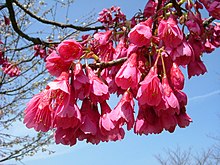| Taiwan cherry | |
|---|---|

| |
| Prunus campanulata blossoms | |
| Scientific classification | |
| Kingdom: | Plantae |
| Clade: | Tracheophytes |
| Clade: | Angiosperms |
| Clade: | Eudicots |
| Clade: | Rosids |
| Order: | Rosales |
| Family: | Rosaceae |
| Genus: | Prunus |
| Subgenus: | Prunus subg. Cerasus |
| Section: | P. sect. Cerasus |
| Species: | P. campanulata |
| Binomial name | |
| Prunus campanulata Maxim. | |
| Synonyms | |
| |
Prunus campanulata is a species of cherry native to Japan, Taiwan, southern and eastern China (Guangxi, Guangdong, Hainan, Hunan, Fujian, and Zhejiang), and Vietnam. It is a large shrub or small tree, growing 3–8 m (10–26 ft) tall. It is widely grown as an ornamental tree, and a symbol of Nago in the Ryukyu Islands of Japan. It is variously known in English as the Taiwan cherry, Formosan cherry, or bellflower cherry. It was described in 1883 by Carl Johann Maximowicz.
Invasive species
The tree is an invasive plant species in the Northland Region of New Zealand. It is illegal to distribute, sell or propagate the plant or to distribute soil, gravel, etc., that contain the seeds or other parts of the plant.
Ecological interactions
Prunus campanulata is the host of larval Chrysozephyrus nishikaze, a butterfly species endemic to Taiwan. Flowers and nectar of Prunus campanulata are among the main food sources of Taiwan yuhinas during their breeding season.
Reproduction
Prunus campanulata is one of the many cherry blossom trees that blooms early. Their seeds portray a physiological and morphological dormancy that is broken when exposed to cold and warm temperatures before germination. The flower is fertilized by pollinating insects and can begin to flower in 1 to 2 years.
Images
-
 Prunus campanulata foliage
Prunus campanulata foliage
-
 Two tūī in a flowering P. campanulata tree
Two tūī in a flowering P. campanulata tree
-
 Prunus campanulata young fruit
Prunus campanulata young fruit
References
- ^ "Plant Name Details for Prunus campanulata". IPNI. Archived from the original on October 17, 2012. Retrieved September 14, 2009.
- "Plant Name Details for Cerasus campanulata". IPNI. Archived from the original on October 17, 2012. Retrieved September 14, 2009.
- "The Plant List, Prunus campanulata Maxim". Archived from the original on 2019-04-11. Retrieved 2015-08-18.
- ^ Li Chaoluan (Li Chao-luang); Jiang Shunyuan; Bruce Bartholomew. "Cerasus campanulata (Maximowicz) A. N. Vassiljeva, 1957. 钟花樱桃 zhong hua ying tao". Flora of China. Archived from the original on 7 April 2016. Retrieved 22 June 2017.
- "Prunus campanulata". Germplasm Resources Information Network. Agricultural Research Service, United States Department of Agriculture. Retrieved 10 January 2018.
- "Northland Pest Management Strategy" (PDF). Northland Regional Council. Archived from the original (PDF) on 21 July 2011. Retrieved 12 August 2010.
- Savela, Markku (8 August 2015). "Chrysozephyrus Shirôzu & Yamamoto, 1956". Lepidoptera and some other life forms. Archived from the original on 11 September 2018. Retrieved 22 June 2017.
- Lee, Pei-Fen; et al. (2005). "Habitat selection of the cooperative breeding Taiwan Yuhina (Yuhina brunneiceps) in a fragmented forest habitat" (PDF). Zoological Studies. 44 (4): 497–504. Archived (PDF) from the original on 2017-08-08. Retrieved 2023-03-31.
External links
| Taxon identifiers | |
|---|---|
| Prunus campanulata |
|
This Prunus article is a stub. You can help Misplaced Pages by expanding it. |